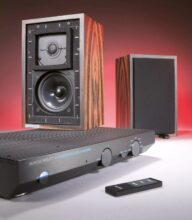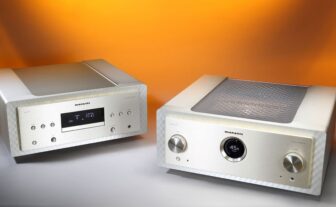HiFi Rose RA280 Integrated Amplifier review
HiFi Rose – the name has so far primarily stood for first-class and easy-to-use streamers. However, the RA280 rightly won this year’s EISA Award in the category of integrated amplifiers.
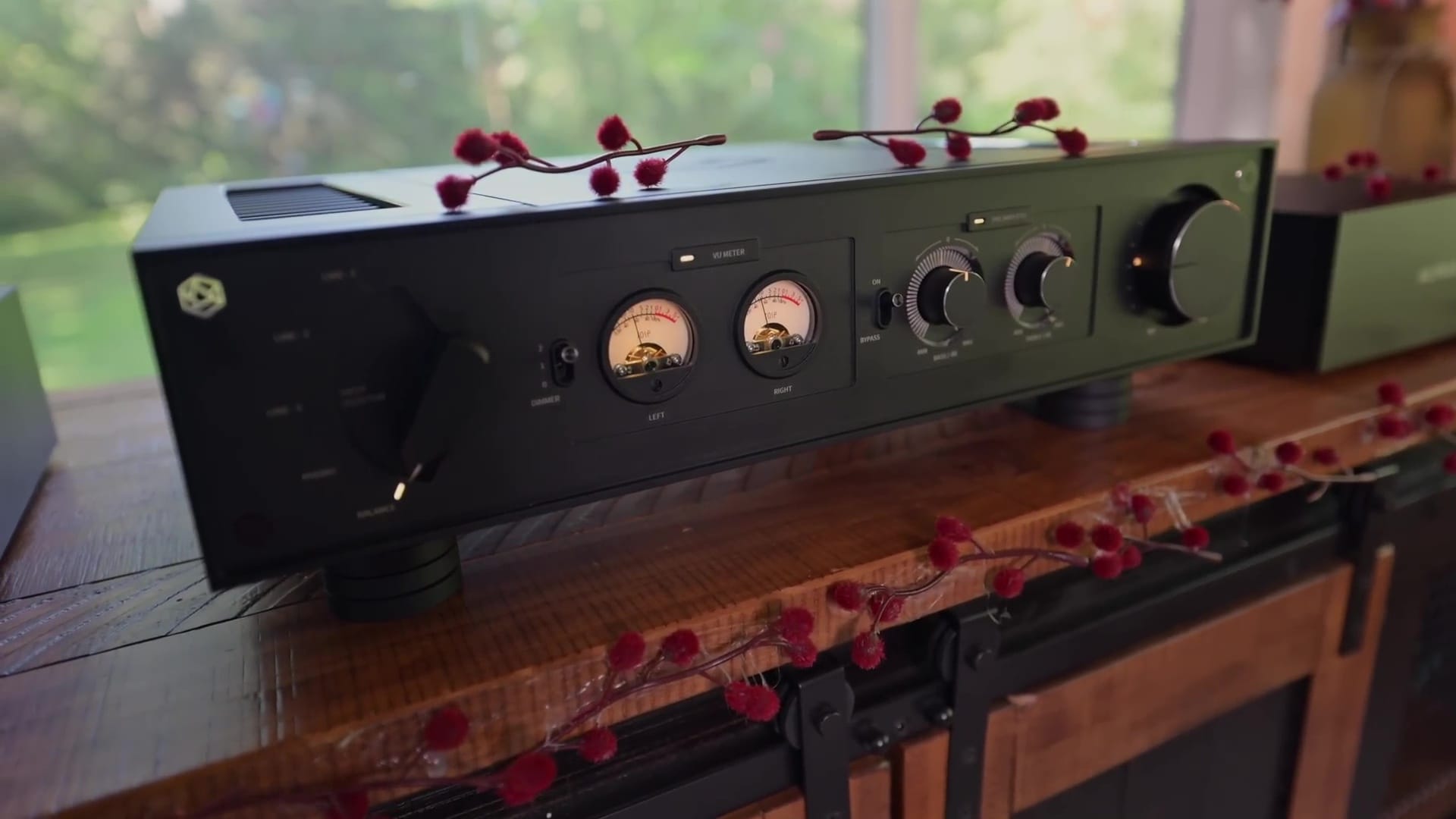
They say the first impression is the most important. In that case, the HiFi Rose RA280 scores a lot of points, as both the appearance and the feel are nearly irresistible.
It shares some similarity with the larger RA180 model but appears less overloaded and playful, making it noticeably tidier. If the input selector reminds you of a Swiss manufacturer of high-end, high-priced products, this view will be reinforced when using it. The two dimmable VU meters also faintly recall what is a signature feature of some other brands, although this design trend seems to be gaining popularity, with several manufacturers now offering this feature in one form or another.
Technically, however, the RA280 is a completely independent product with proprietary circuitry, an in-house power supply, and transistors that we have not encountered in other products before.
In addition, the RA280 stands out with its analog soul, which is somewhat surprising given that the Korean brand has made waves in the digital world with its streamers in recent years. However, there is no digital-to-analog converter or streaming unit here, but rather a phono input that is only designed for MM or high-output MC systems. There are no adjustment options for gain or capacitance to fine-tune the sound to match the cartridge and achieve optimal sound.
Features: good, but not lavish
The device is quite generous in other areas: it offers switchable bass and treble controls on the front, while the back is equipped with three very solid RCA inputs, a balanced XLR input, and a separate subwoofer output in RCA format. It also includes trigger inputs and outputs. The speaker terminals are solid and insulated with plastic to prevent short circuits. They accept bare wires, spades, or banana plugs. There are grounding terminals for the turntable cable and another for eliminating ground loops when used with other devices.

If you’re looking for a traditional glass fuse, you’ll be disappointed. In case of issues such as a short circuit or the unlikely event of overheating, the device will shut off and can be restarted using the “Circuit Breaker Reset” button. There is no preamplifier output, home theater functionality, or headphone jack.

Whether the remote control is a disappointment or a joy depends on the user: some prefer a full version that allows for source selection, while others are happy with just power, mute, and volume control. The latter group will likely appreciate the minimalist metal remote that fits comfortably in the hand.
Unique technology
Fundamentally, the RA280 is a Class D amplifier, meaning it is energy-efficient, with around 90% of the power converted into sound and only 10% lost as heat.
However, like any technology, Class D amplifiers have downsides. Traditional Class D designs have limited bandwidth, which restricts the frequency response just above the hearing threshold of 20kHz. While this doesn’t impact treble reproduction, it often contributes to a slightly less clean and dynamic sound.
Another downside is that the frequency response changes depending on the speaker’s impedance. Since speakers do not offer a constant resistance and tend to fluctuate, this results in an uneven frequency response, potentially leading to treble loss in extreme cases.
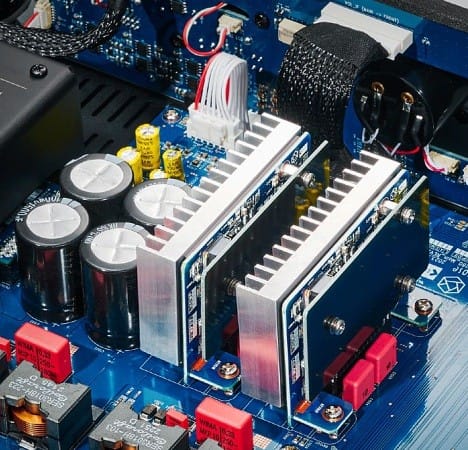
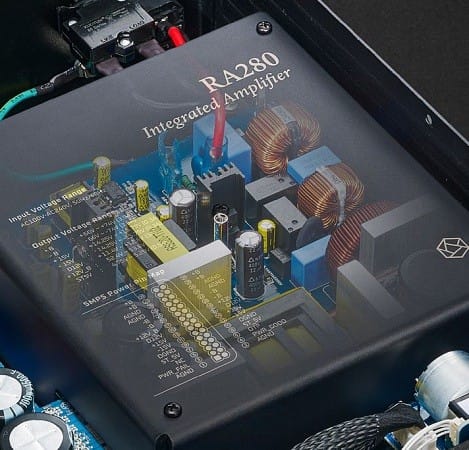
Rather than using off-the-shelf modules from companies like Pascal, Texas Instruments, or Purifi, the Koreans developed their own amplifier module with gallium nitride field-effect transistors, which boast a high switching frequency and wide bandwidth. This is said to result in superior linearity. HiFi Rose has labeled this design “AD,” standing for “Advanced Class D.”
TEST EQUIPMENT
Turntable: Music Hall Stealth Streamer/DAC: Eversolo DMP-A8
Amplifiers: Prima Luna Evo 400, Exposure 2510
Speakers: Audiovector Trapeze RI
Cables: Audioquest, Inak, Silent Wire
Modern and proven
The power supply was also self-developed and delivers nearly identical performance at 4 and 8 ohms. Instead of traditional silicon FETs, silicon carbide is used, which offers higher maximum voltage and handles higher temperatures better than other types, according to HiFi Rose. To ensure a stable power supply under all conditions without overloading the power supply, the maximum output is limited to 250 watts per channel by an overcurrent protection circuit, which should be more than enough for most applications.
The volume control uses an Alps motorized potentiometer, a well-proven solution, although it seems somewhat out of place in such a modern device. However, there is little to criticize in terms of its quality, as the listening test soon confirmed. Our test unit was already broken in, so after determining the correct power plug polarity and connecting the system, we could start testing right away.

Sound Quality
From the very first notes of Wayne Shorter’s “Speak No Evil,” it became clear that the RA280 is not only powerful but also one of the most neutral amplifiers in the best sense. It skillfully balanced the tones of saxophone, bass, and drums, delivering dynamic precision in the bass and effortless ease, without ever sounding disengaged, cold, or emotionally restrained.
»EXCELLENT BUILD, GOOD FEATURES, AND A VERY NEUTRAL SOUND DELIVER A CONVINCING PERFORMANCE.«
Equally impressive was Tony Bennett’s voice—next to Frank Sinatra, probably the most famous “crooner”—which, in “Some Other Time,” superbly accompanied by Bill Evans on piano, showed that Bennett was much more than just a singer of American ballads. The RA280 supported Evans’ piano play without becoming overly analytical or slowing down the dynamic range.
The RA280 also excelled with female vocals, as demonstrated by Billie Holiday. Her voice, along with trumpet, saxophone, piano, bass, and delicately impulsive drums, sounded as though they were performing on a stage directly in the listening room. The positioning was precise, although slightly less laid-back and deep in the room than is sometimes heard. However, this did not detract from the excellent overall quality and left room for personal preference.
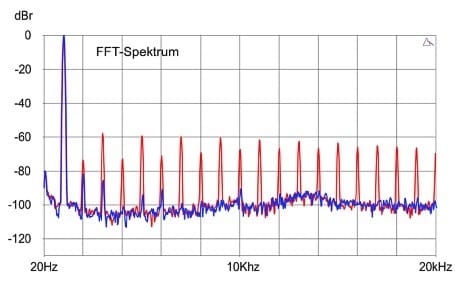
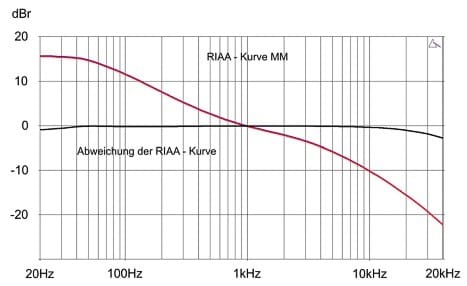
Specs
Product Type / Price Range: Transistor Integrated Amplifier / €2,000 to €5,000
Website: hifirose.com
Price in Euros: €3,300
Dimensions (W x H x D) in cm / Weight in kg: 43 x 10.3 x 35.5 / 9.5 kg
Sound (55%): 8.5/10
- Sound Quality: Very neutral with excellent spatial representation and high power reserves
- Score: 8.5/10
Measurements (10%): 7.5/10
- Continuous Output per Channel at 4 Ohms, 1% THD (in Watts): Very high (355 W)
- Impulse Power at 4 Ohms (1 kHz, in Watts): Very high (355 W)
- Intermodulation Distortion at 5 Watts (in %): Very low (0.0058%)
- Damping Factor at 4 Ohms: High (42)
- Channel Separation (in dB): High (69 dB)
- Channel Balance at Full Volume (in dB): Poor (2 dB)
- Upper Frequency Limit (in kHz): Very poor (22 kHz)
- Distortion Factor at 5 Watts (in %): Low (0.014%)
- Noise Floor at 5 Watts (in dB): Somewhat poor (80 dB)
- FFT Spectrum: Poor
- Score: 7.5/10
Features (15%): 5.5/10
- Build Quality: Very good
- Number of Analog Inputs (RCA / XLR): 3 x RCA, 1 x XLR
- Special Interfaces / Pre-Out: Only Phono MM / No
- Tone Control or Room Measurement: Yes
- Color Variants / Finishes: Silver/Black
- Score: 5.5/10
Operation & Usability (15%): 5.5/10
- Remote Control / Manual Quality: Good / Poor
- Device Control / Display Quality: Very good
- Score: 5.5/10
Service & Environment (5%): 4.5/10
- Warranty (in Years): 2
- Packaging: Double cardboard box with foam padding
- Power Consumption in Standby / Idle (in Watts): High (0 / 36 W)
- Hard Power Switch: No
- Score: 4.5/10

When you purchase through links on our site, I may earn an affiliate commission. Here’s how it works.
HiFi Rose RA280 Integrated Amplifier: Class AD w/ Next-Generation GaN FET Technology
The HiFi Rose RA280 Reference Integrated Amplifier is all about the music, giving you the same great GaN FET amplifier ...
HiFi Rose RA280 Amplifier Review: Is it WORTH it? (2024)
In this detailed review, we dive into the HiFi Rose RA280 Amplifier to determine if it truly lives up to the hype in 2024. Discover the ...









